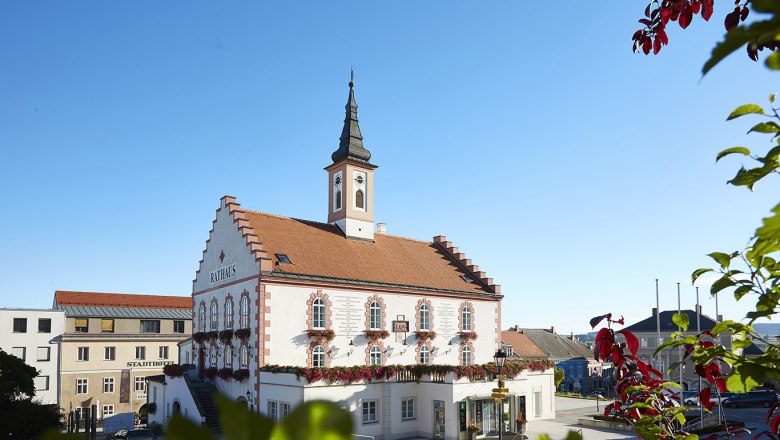Walled Town of Waidhofen an der Thaya
Old handicrafts and a lively atmosphere
The historical center of Waidhofen sits on a high rock plateau overlooking the Thaya and is still surrounded by its ancient town walls. You cross the Thaya bridge and follow the street as it ascends steeply toward the Baroque parish church. In this, the northernmost district seat in Austria, history and tradition meet the future. From the weaving museum to the world’s largest waldrapp aviary, Waidhofen has many rare finds in store for visitors.
Life in an ancient border area
Waidhofen an der Thaya was first mentioned in 1171 and received town privileges in 1230. The Counts of Pernegg are considered the founders. Waidhofen together with the towns of Weitra, Litschau and Drosendorf formed the defense line against the Kingdom of Bohemia. Owing to its location on the border, the town had to fight off enemy attacks time and time again but it was virtually never captured. The situation did not calm down until 1526. It was in that year that the Habsburgs acquired Bohemia and Moravia – and Waidhofen retained town privileges from these rulers until 1848 with the status of territorial city (“landesfürstliche Stadt”). At the end of the 17th c, the local cottage industry in textiles saw an economic upswing. Waidhofen an der Thaya along with Krems an der Donau grew to be the key industrial towns in the Waldviertel. The local Capuchin monastery that had been dissolved under Emperor Joseph II in 1784 became the site of the first regional ribbon weaving mill with a workforce of 350 people. Year after year, Waidhofen developed into the economic and cultural hub of the entire administrative district as a center of government administration and schools and as a location for numerous industrial enterprises and museums.
New life within ancient walls
Impressively well-preserved: The fortification still retains its original triangular shape with a large square reminiscent of a village green. The town walls surround the historical center. They are three kilometers long and up to two meters thick in many places. The southern and northern promenades with their powder towers are inviting places to stroll outside the walls. To the west, the site of the former town moat is now covered with fragrant gardens. Today, the Baroque parish church sits enthroned at the highest point in the complex – its Gothic predecessor stood here until the early 18th c. In 1713, the current nave was built over the old one – the final dismantling of the Gothic church underneath did not occur until the outside walls of the new structure were completed. These age-old construction methods are something to behold, as is the complex itself.
A lively cultural scene all year round
People enjoy reciting the history of the ancient fortifications. At Theater an der Mauer, part of the old wall is integrated in the auditorium. Under a single roof, the town museum combines town history, the Waldviertel weaving museum and special exhibitions that alternate annually. Don’t be startled: Several of the centuries-old exhibits here “start talking”. Georg Herold’s six-meter-long larch-wood rendition of Albrecht Dürer’s rabbit has been decorating a local roundabout since May 2013 – age-old art in a new guise!
Town life with rare and unique aspects
Cycle on the Thaya Circuit Cycle Route, check out the world’s largest waldrapp aviary, visit the chocolate manufactory of Andreas Müssauer or explore a site called the Grosse Basilika. Many roads lead to happiness here. The last site mentioned is perfect for deep relaxation. You are sure to find an interesting meditation field among the 97 diorite erratics arranged there. Are you an avid walker? Off to Frühwärts: Austria’s oldest terrycloth weaving mill is directly on the Waldviertel Textile Route. Enjoy the interactive tour and a world of new experiences!





